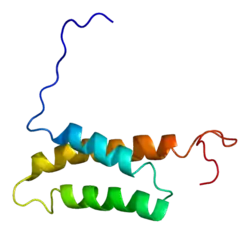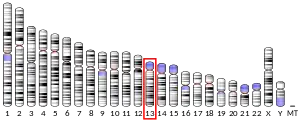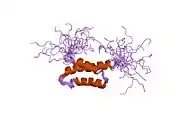Sacsin
Sacsin also known as DnaJ homolog subfamily C member 29 (DNAJC29) is a protein that in humans is encoded by the SACS gene.[3][4] Sacsin is a Hsp70 co-chaperone.[5]
| SACS | |||||||||||||||||||||||||||||||||||||||||||||||||||
|---|---|---|---|---|---|---|---|---|---|---|---|---|---|---|---|---|---|---|---|---|---|---|---|---|---|---|---|---|---|---|---|---|---|---|---|---|---|---|---|---|---|---|---|---|---|---|---|---|---|---|---|
 | |||||||||||||||||||||||||||||||||||||||||||||||||||
| |||||||||||||||||||||||||||||||||||||||||||||||||||
| Identifiers | |||||||||||||||||||||||||||||||||||||||||||||||||||
| Aliases | SACS, ARDNAJC29, PPP1R138, SPAX6, sacsin molecular chaperone | ||||||||||||||||||||||||||||||||||||||||||||||||||
| External IDs | OMIM: 604490 HomoloGene: 8653 GeneCards: SACS | ||||||||||||||||||||||||||||||||||||||||||||||||||
| |||||||||||||||||||||||||||||||||||||||||||||||||||
| |||||||||||||||||||||||||||||||||||||||||||||||||||
| |||||||||||||||||||||||||||||||||||||||||||||||||||
| |||||||||||||||||||||||||||||||||||||||||||||||||||
| Wikidata | |||||||||||||||||||||||||||||||||||||||||||||||||||
| |||||||||||||||||||||||||||||||||||||||||||||||||||
Function
This gene consists of nine exons including a gigantic exon spanning more than 12.8k bp. It encodes the sacsin protein, which includes a UBQ region at the N-terminus, a HEPN domain at the C-terminus and a DnaJ region upstream of the HEPN domain. This modular protein is essential for normal mitochondrial network organization.[6] The gene is highly expressed in the central nervous system, also found in skin, skeletal muscles and at low levels in the pancreas. Mutations in this gene result in autosomal recessive spastic ataxia of Charlevoix-Saguenay (ARSACS), a neurodegenerative disorder characterized by early-onset cerebellar ataxia with spasticity and peripheral neuropathy.[4]
Clinical significance
Autosomal recessive spastic ataxia of Charlevoix-Saguenay (ARSACS) is a very rare neurodegenerative genetic disorder that results from mutations in the gene that produces Sacsin. Afflicted persons suffer from loss of balance, loss of muscle control and spasticity.[7]
References
- GRCh38: Ensembl release 89: ENSG00000151835 - Ensembl, May 2017
- "Human PubMed Reference:". National Center for Biotechnology Information, U.S. National Library of Medicine.
- Engert JC, Doré C, Mercier J, Ge B, Bétard C, Rioux JD, Owen C, Bérubé P, Devon K, Birren B, Melançon SB, Morgan K, Hudson TJ, Richter A (December 1999). "Autosomal recessive spastic ataxia of Charlevoix-Saguenay (ARSACS): high-resolution physical and transcript map of the candidate region in chromosome region 13q11". Genomics. 62 (2): 156–64. doi:10.1006/geno.1999.6003. PMID 10610707.
- "Entrez Gene: SACS spastic ataxia of Charlevoix-Saguenay (sacsin)".
- Parfitt DA, Michael GJ, Vermeulen EG, Prodromou NV, Webb TR, Gallo JM, Cheetham ME, Nicoll WS, Blatch GL, Chapple JP (May 2009). "The ataxia protein sacsin is a functional co-chaperone that protects against polyglutamine-expanded ataxin-1". Human Molecular Genetics. 18 (9): 1556–65. doi:10.1093/hmg/ddp067. PMC 2667285. PMID 19208651.
- Bradshaw TY, Romano LE, Duncan EJ, Nethisinghe S, Abeti R, Michael GJ, Giunti P, Vermeer S, Chapple JP (June 2016). "A reduction in Drp1-mediated fission compromises mitochondrial health in autosomal recessive spastic ataxia of Charlevoix Saguenay". Human Molecular Genetics. 25 (15): 3232–3244. doi:10.1093/hmg/ddw173. PMC 5179924. PMID 27288452.
- "ARSACS". Genetics Home Reference. Retrieved 19 January 2017.
Further reading
- Nagase T, Ishikawa K, Suyama M, Kikuno R, Miyajima N, Tanaka A, Kotani H, Nomura N, Ohara O (October 1998). "Prediction of the coding sequences of unidentified human genes. XI. The complete sequences of 100 new cDNA clones from brain which code for large proteins in vitro". DNA Research. 5 (5): 277–86. doi:10.1093/dnares/5.5.277. PMID 9872452.
- Engert JC, Bérubé P, Mercier J, Doré C, Lepage P, Ge B, Bouchard JP, Mathieu J, Melançon SB, Schalling M, Lander ES, Morgan K, Hudson TJ, Richter A (February 2000). "ARSACS, a spastic ataxia common in northeastern Québec, is caused by mutations in a new gene encoding an 11.5-kb ORF". Nature Genetics. 24 (2): 120–5. doi:10.1038/72769. PMID 10655055. S2CID 19667726.
- Mercier J, Prévost C, Engert JC, Bouchard JP, Mathieu J, Richter A (2001). "Rapid detection of the sacsin mutations causing autosomal recessive spastic ataxia of Charlevoix-Saguenay". Genetic Testing. 5 (3): 255–9. doi:10.1089/10906570152742326. PMID 11788093.
- Criscuolo C, Banfi S, Orio M, Gasparini P, Monticelli A, Scarano V, Santorelli FM, Perretti A, Santoro L, De Michele G, Filla A (January 2004). "A novel mutation in SACS gene in a family from southern Italy". Neurology. 62 (1): 100–2. doi:10.1212/wnl.62.1.100. PMID 14718706. S2CID 42697050.
- Grieco GS, Malandrini A, Comanducci G, Leuzzi V, Valoppi M, Tessa A, Palmeri S, Benedetti L, Pierallini A, Gambelli S, Federico A, Pierelli F, Bertini E, Casali C, Santorelli FM (January 2004). "Novel SACS mutations in autosomal recessive spastic ataxia of Charlevoix-Saguenay type". Neurology. 62 (1): 103–6. doi:10.1212/01.wnl.0000104491.66816.77. PMID 14718707. S2CID 8767156.
- Ogawa T, Takiyama Y, Sakoe K, Mori K, Namekawa M, Shimazaki H, Nakano I, Nishizawa M (January 2004). "Identification of a SACS gene missense mutation in ARSACS". Neurology. 62 (1): 107–9. doi:10.1212/01.wnl.0000099371.14478.73. PMID 14718708. S2CID 46133910.
- Richter AM, Ozgul RK, Poisson VC, Topaloglu H (September 2004). "Private SACS mutations in autosomal recessive spastic ataxia of Charlevoix-Saguenay (ARSACS) families from Turkey". Neurogenetics. 5 (3): 165–70. doi:10.1007/s10048-004-0179-y. PMID 15156359. S2CID 13187102.
- Shimazaki H, Takiyama Y, Sakoe K, Ando Y, Nakano I (June 2005). "A phenotype without spasticity in sacsin-related ataxia". Neurology. 64 (12): 2129–31. doi:10.1212/01.WNL.0000166031.91514.B3. PMID 15985586. S2CID 22975541.
- Yamamoto Y, Hiraoka K, Araki M, Nagano S, Shimazaki H, Takiyama Y, Sakoda S (December 2005). "Novel compound heterozygous mutations in sacsin-related ataxia". Journal of the Neurological Sciences. 239 (1): 101–4. doi:10.1016/j.jns.2005.08.005. PMID 16198375. S2CID 22286305.
- Ouyang Y, Takiyama Y, Sakoe K, Shimazaki H, Ogawa T, Nagano S, Yamamoto Y, Nakano I (April 2006). "Sacsin-related ataxia (ARSACS): expanding the genotype upstream from the gigantic exon". Neurology. 66 (7): 1103–4. doi:10.1212/01.wnl.0000204300.94261.ea. PMID 16606928. S2CID 19513985.
- Takado Y, Hara K, Shimohata T, Tokiguchi S, Onodera O, Nishizawa M (April 2007). "New mutation in the non-gigantic exon of SACS in Japanese siblings". Movement Disorders. 22 (5): 748–9. doi:10.1002/mds.21365. PMID 17290461. S2CID 23132322.
External links
- GeneReviews/NCBI/NIH/UW entry on ARSACS - Autosomal Recessive Spastic Ataxia of Charlevoix-Saguenay
- OMIM entries on ARSACS - Autosomal Recessive Spastic Ataxia of Charlevoix-Saguenay
This article incorporates text from the United States National Library of Medicine, which is in the public domain.



